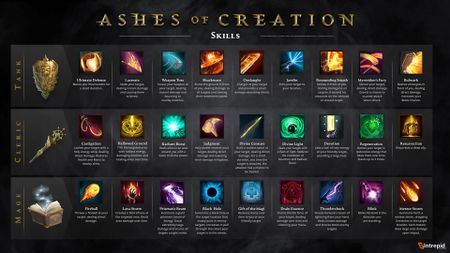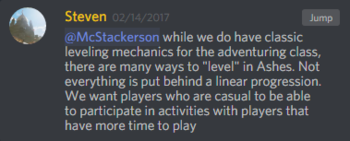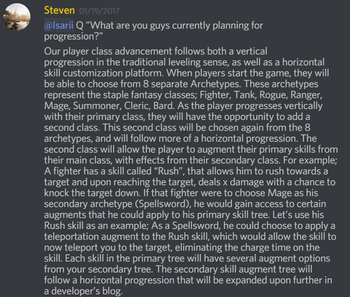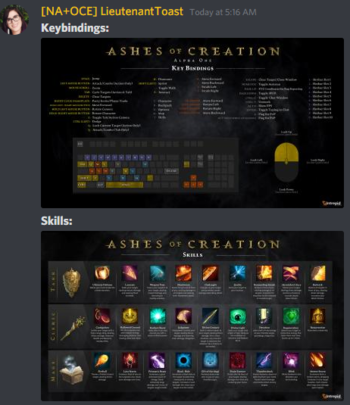Diferenças entre edições de "Leveling"
(Edit citations) |
|||
| Linha 15: | Linha 15: | ||
{{Class abilities}} | {{Class abilities}} | ||
| + | |||
| + | == Rested experience == | ||
| + | |||
| + | {{Rested experience}} | ||
== See also == | == See also == | ||
Revisão das 15h18min de 6 de novembro de 2017
Nivelamento won't follow a traditional linear path, although classic mechanics for leveling exist.[1]
- Progression occurs through a variety of pathways.[2]
- Repetition will not be part of progression in Ashes of Creation.[3]
Class progression
À medida que um jogador progride com seu modelo primário, ele terá a oportunidade de escolher um modelo secundário para modificar suas habilidades primárias com efeitos do modelo secundário.[4][5] A combinação de modelos primários e secundários constitui uma classe.[4][6][7]
Se um Lutador escolhesse Mage como seu modelo secundário, esse lutador se tornaria um Spellsword. Essa combinação abre espaço para modificações que podem ser aplicadas às habilidades da árvore de habilidades primária. Lutadores têm a habilidade Investida que permite que eles avancem contra um alvo; ao chegar nesse alvo, eles causam uma certa quantia de dano com a chance de derrubar o oponente. A modificação Mage's escape poderia ser aplicada à habilidade Investida, que agora teleportaria o jogador para o alvo , eliminando o tempo necessário para avançar até o inimigo.[5]
Cada habilidade na árvore primária terá diversas opções de modificação vindas árvore secundária. Esse é um exemplo de progressão horizontal.[5]
- Modificações em habilidades primárias mudarão fundamentalmente a maneira como as habilidades funcionam - adaptando o que a habilidade fazia para incorporar a identidade do segundo modelo/classe.[8]
- Uma classe secundária não ofereçerá habilidades adicionais.[9]
Os jogadores recebem pontos de habilidade quando sobem de nível. Esses pontos são usados para aumentar o nível das habilidades na árvore de habilidade.[10]
- Não será possível maximizar o nível de todas as habilidades em uma árvore de habilidades.[10]
Classes by archetype combination
Com 8 Modelos para combinar, jogadores poderão escolher um total de 64 combinações para criar suas próprias classes.[4][6][7]
Class abilities

If from the eight archetypes whatever you choose as your secondary, you're going to receive a choice of augments that relate to some core ideal of that class. You know like a tank is about controlling the battlefield, is about surviving. The mage is about dealing damage and elements and ability in AoEs. The rogue is going to be about stealth and critical damage. So those augments are going to to play towards those identities.[12] – Steven Sharif
The idea behind the system is that you're skirting the line through these augmentations of your role, right. We have the traditional holy trinity that's present in class designs for MMOs and it's often that those either are not deviated at all or completely deviated from entirely. The augment is to offer a balance between that where you still maintain the semblance of that trinity system while offering the opportunity to customize your play experience towards one of the other angles in the triangle.[13] – Steven Sharif
Primary skills (class abilities) are based on a player's archetype.[14][5]
- A player may choose a secondary archetype when they reach level 25.[15][4] The player can then augment their primary skills with effects from their secondary archetype.[14][15][4][5][16]
- Outside of class-specific skills there may be a subset of universal skills, such as active block and dodge.[17]
- Class skills are not affected by the type of weapon that is equipped.[18]
- Primary skills in Alpha-2 are expected to be very different to those in Alpha-1.[19]
Rested experience
Tavernas offer rested experience (rested XP) for those who rent rooms or spend time as patrons of the tavern.[20][21]
- Rested experience allows players to gain experience at a faster rate for a period of time.[21]
- There are no current plans to replace rested experience with another bonus for max-level players.[22]
- Rested experience increases the rate that experience debt is paid back.[23]
Ver também
Referências
- ↑

- ↑ Livestream, 19 May 2017 (51:52)
- ↑ Livestream, 12 May 2017 (42:17)
- ↑ 4.0 4.1 4.2 4.3 4.4 4.5 Entrevista, 2020-07-18 (1:05:04).
- ↑ 5.0 5.1 5.2 5.3 5.4

- ↑ 6.0 6.1 Ashes of Creation class list.
- ↑ 7.0 7.1

- ↑ February 8, 2019 - Questions and Answers.
- ↑ Transmissão ao vivo, 2017-05-03 (50:50).
- ↑ 10.0 10.1 Transmissão ao vivo, 2017-07-28 (19:05).
- ↑

- ↑ Transmissão ao vivo, 2017-10-16 (1:00:44).
- ↑ Entrevista, 2018-08-08 (22:27).
- ↑ 14.0 14.1 Transmissão ao vivo, 2023-12-19 (1:20:41).
- ↑ 15.0 15.1 Transmissão ao vivo, 2023-07-28 (1:04:27).
- ↑

- ↑ Transmissão ao vivo, 2021-11-19 (50:38).
- ↑ Vídeo, 2022-09-30 (17:00).
- ↑ Transmissão ao vivo, 2021-09-24 (1:18:06).
- ↑ Transmissão ao vivo, 2023-06-30 (27:52).
- ↑ 21.0 21.1 The mighty beard!
- ↑ Transmissão ao vivo, 2023-06-30 (1:22:32).
- ↑ Transmissão ao vivo, 2023-09-29 (1:18:04).